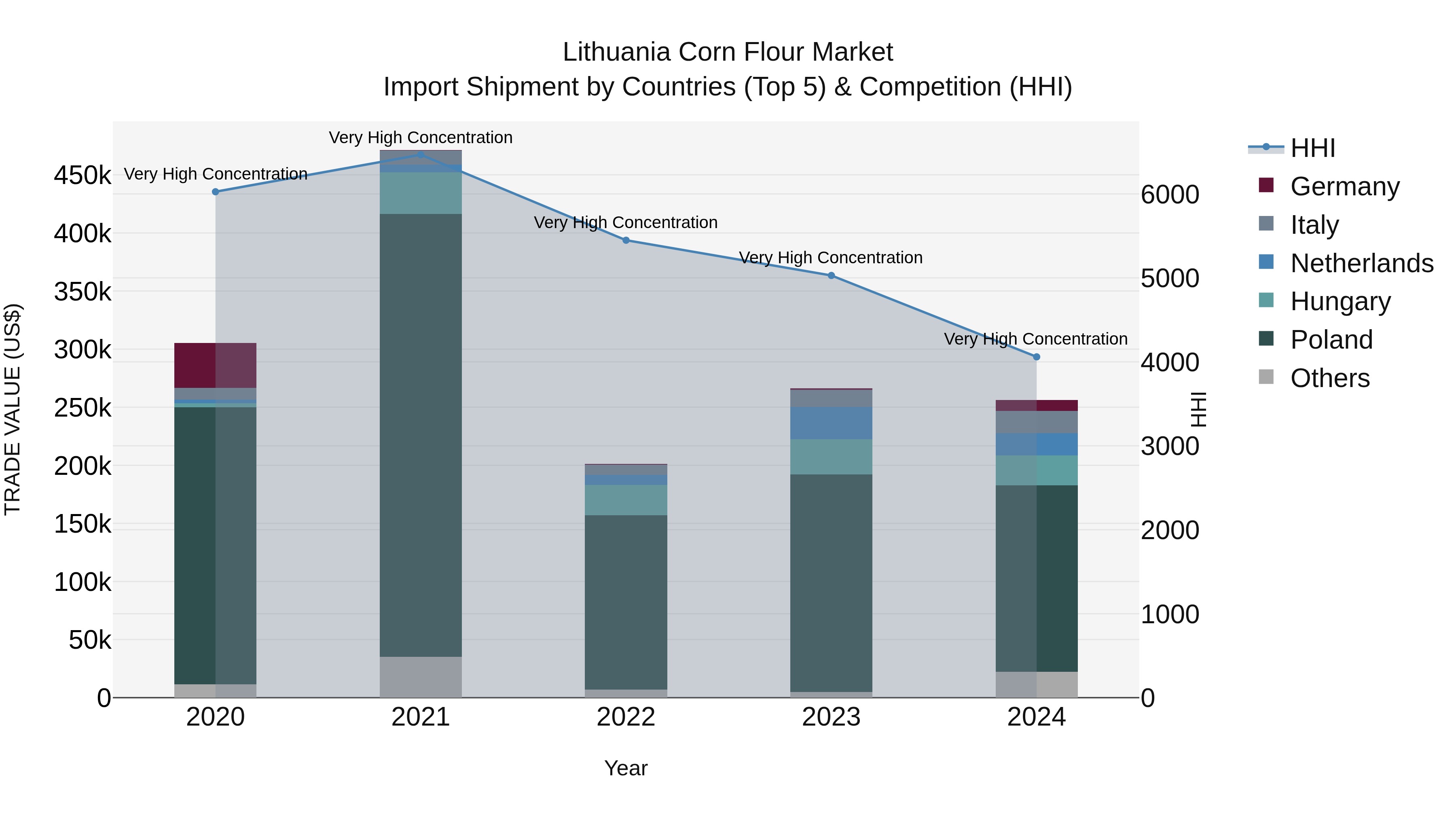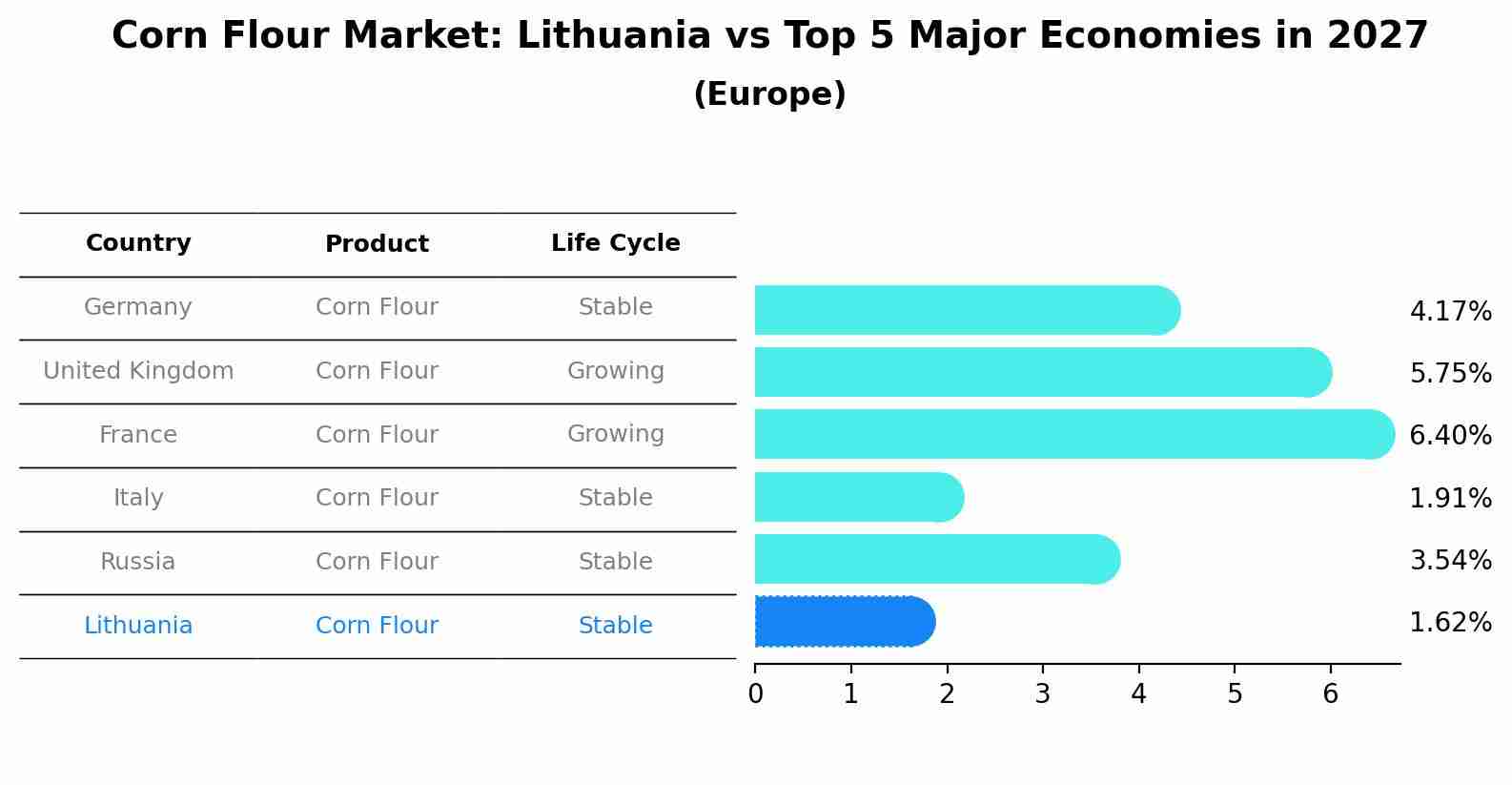Lithuania Corn Flour Market (2025-2031) | Size, Revenue, Industry, Value, Outlook, Trends, Share, Forecast, Segmentation, Analysis, Growth & Companies
| Product Code: ETC4844318 | Publication Date: Nov 2023 | Updated Date: Nov 2025 | Product Type: Market Research Report | |
| Publisher: 6Wresearch | Author: Shubham Padhi | No. of Pages: 60 | No. of Figures: 30 | No. of Tables: 5 |
Lithuania Corn Flour Market Top 5 Importing Countries and Market Competition (HHI) Analysis
Despite the declining Compound Annual Growth Rate (CAGR) from 2020 to 2024 and a negative growth rate in 2024, Lithuania continues to heavily rely on corn flour imports from top countries such as Poland, Hungary, Netherlands, Italy, and Croatia. The High Herfindahl-Hirschman Index (HHI) indicates a highly concentrated market. This suggests that these top exporting countries hold significant market power in supplying corn flour to Lithuania, possibly influencing prices and availability in the market. Monitoring these trends can provide valuable insights for stakeholders in the corn flour import industry in Lithuania.

Corn Flour Market: Lithuania vs Top 5 Major Economies in 2027 (Europe)
By 2027, Lithuania's Corn Flour market is forecasted to achieve a stable growth rate of 1.62%, with Germany leading the Europe region, followed by United Kingdom, France, Italy and Russia.

Key Highlights of the Report:
- Lithuania Corn Flour Market Outlook
- Market Size of Lithuania Corn Flour Market, 2024
- Forecast of Lithuania Corn Flour Market, 2031
- Historical Data and Forecast of Lithuania Corn Flour Revenues & Volume for the Period 2021-2031
- Lithuania Corn Flour Market Trend Evolution
- Lithuania Corn Flour Market Drivers and Challenges
- Lithuania Corn Flour Price Trends
- Lithuania Corn Flour Porter`s Five Forces
- Lithuania Corn Flour Industry Life Cycle
- Historical Data and Forecast of Lithuania Corn Flour Market Revenues & Volume By Application for the Period 2021-2031
- Historical Data and Forecast of Lithuania Corn Flour Market Revenues & Volume By Bakery And Confectionary for the Period 2021-2031
- Historical Data and Forecast of Lithuania Corn Flour Market Revenues & Volume By Snack Food for the Period 2021-2031
- Historical Data and Forecast of Lithuania Corn Flour Market Revenues & Volume By Others for the Period 2021-2031
- Historical Data and Forecast of Lithuania Corn Flour Market Revenues & Volume By Distribution Channel for the Period 2021-2031
- Historical Data and Forecast of Lithuania Corn Flour Market Revenues & Volume By Online Retail for the Period 2021-2031
- Historical Data and Forecast of Lithuania Corn Flour Market Revenues & Volume By Supermarkets/Hypermarkets for the Period 2021-2031
- Historical Data and Forecast of Lithuania Corn Flour Market Revenues & Volume By Convenience Stores for the Period 2021-2031
- Historical Data and Forecast of Lithuania Corn Flour Market Revenues & Volume By Others for the Period 2021-2031
- Lithuania Corn Flour Import Export Trade Statistics
- Market Opportunity Assessment By Application
- Market Opportunity Assessment By Distribution Channel
- Lithuania Corn Flour Top Companies Market Share
- Lithuania Corn Flour Competitive Benchmarking By Technical and Operational Parameters
- Lithuania Corn Flour Company Profiles
- Lithuania Corn Flour Key Strategic Recommendations
Frequently Asked Questions About the Market Study (FAQs):
1 Executive Summary |
2 Introduction |
2.1 Key Highlights of the Report |
2.2 Report Description |
2.3 Market Scope & Segmentation |
2.4 Research Methodology |
2.5 Assumptions |
3 Lithuania Corn Flour Market Overview |
3.1 Lithuania Country Macro Economic Indicators |
3.2 Lithuania Corn Flour Market Revenues & Volume, 2021 & 2031F |
3.3 Lithuania Corn Flour Market - Industry Life Cycle |
3.4 Lithuania Corn Flour Market - Porter's Five Forces |
3.5 Lithuania Corn Flour Market Revenues & Volume Share, By Application, 2021 & 2031F |
3.6 Lithuania Corn Flour Market Revenues & Volume Share, By Distribution Channel, 2021 & 2031F |
4 Lithuania Corn Flour Market Dynamics |
4.1 Impact Analysis |
4.2 Market Drivers |
4.2.1 Growing consumer awareness about the health benefits of corn flour |
4.2.2 Increasing demand for gluten-free products |
4.2.3 Rise in the consumption of convenience foods |
4.3 Market Restraints |
4.3.1 Fluctuating prices of raw materials |
4.3.2 Intense competition from other alternative flours |
4.3.3 Regulatory challenges related to food safety and labeling |
5 Lithuania Corn Flour Market Trends |
6 Lithuania Corn Flour Market Segmentations |
6.1 Lithuania Corn Flour Market, By Application |
6.1.1 Overview and Analysis |
6.1.2 Lithuania Corn Flour Market Revenues & Volume, By Bakery And Confectionary, 2021-2031F |
6.1.3 Lithuania Corn Flour Market Revenues & Volume, By Snack Food, 2021-2031F |
6.1.4 Lithuania Corn Flour Market Revenues & Volume, By Others, 2021-2031F |
6.2 Lithuania Corn Flour Market, By Distribution Channel |
6.2.1 Overview and Analysis |
6.2.2 Lithuania Corn Flour Market Revenues & Volume, By Online Retail, 2021-2031F |
6.2.3 Lithuania Corn Flour Market Revenues & Volume, By Supermarkets/Hypermarkets, 2021-2031F |
6.2.4 Lithuania Corn Flour Market Revenues & Volume, By Convenience Stores, 2021-2031F |
6.2.5 Lithuania Corn Flour Market Revenues & Volume, By Others, 2021-2031F |
7 Lithuania Corn Flour Market Import-Export Trade Statistics |
7.1 Lithuania Corn Flour Market Export to Major Countries |
7.2 Lithuania Corn Flour Market Imports from Major Countries |
8 Lithuania Corn Flour Market Key Performance Indicators |
8.1 Consumer demand for gluten-free products in the Lithuanian market |
8.2 Adoption rate of corn flour in the food processing industry |
8.3 Consumer preferences towards convenience foods containing corn flour |
9 Lithuania Corn Flour Market - Opportunity Assessment |
9.1 Lithuania Corn Flour Market Opportunity Assessment, By Application, 2021 & 2031F |
9.2 Lithuania Corn Flour Market Opportunity Assessment, By Distribution Channel, 2021 & 2031F |
10 Lithuania Corn Flour Market - Competitive Landscape |
10.1 Lithuania Corn Flour Market Revenue Share, By Companies, 2024 |
10.2 Lithuania Corn Flour Market Competitive Benchmarking, By Operating and Technical Parameters |
11 Company Profiles |
12 Recommendations | 13 Disclaimer |
- Single User License$ 1,995
- Department License$ 2,400
- Site License$ 3,120
- Global License$ 3,795
Search
Related Reports
- Vietnam System Integrator Market (2025-2031) | Size, Companies, Analysis, Industry, Value, Forecast, Growth, Trends, Revenue & Share
- ASEAN and Thailand Brain Health Supplements Market (2025-2031) | Strategy, Consumer Insights, Analysis, Investment Trends, Opportunities, Growth, Size, Share, Industry, Revenue, Segments, Value, Segmentation, Supply, Forecast, Restraints, Outlook, Competition, Drivers, Trends, Demand, Pricing Analysis, Competitive, Strategic Insights, Companies, Challenges
- ASEAN Bearings Market (2025-2031) | Strategy, Consumer Insights, Analysis, Investment Trends, Opportunities, Growth, Size, Share, Industry, Revenue, Segments, Value, Segmentation, Supply, Forecast, Restraints, Outlook, Competition, Drivers, Trends, Demand, Pricing Analysis, Competitive, Strategic Insights, Companies, Challenges
- Europe Flooring Market (2025-2031) | Outlook, Share, Industry, Trends, Forecast, Companies, Revenue, Size, Analysis, Growth & Value
- Saudi Arabia Manlift Market (2025-2031) | Outlook, Size, Growth, Trends, Companies, Industry, Revenue, Value, Share, Forecast & Analysis
- Uganda Excavator, Crane, and Wheel Loaders Market (2025-2031) | Strategy, Consumer Insights, Analysis, Investment Trends, Opportunities, Growth, Size, Share, Industry, Revenue, Segments, Value, Segmentation, Supply, Forecast, Restraints, Outlook, Competition, Drivers, Trends, Demand, Pricing Analysis, Competitive, Strategic Insights, Companies, Challenges
- Rwanda Excavator, Crane, and Wheel Loaders Market (2025-2031) | Strategy, Consumer Insights, Analysis, Investment Trends, Opportunities, Growth, Size, Share, Industry, Revenue, Segments, Value, Segmentation, Supply, Forecast, Restraints, Outlook, Competition, Drivers, Trends, Demand, Pricing Analysis, Competitive, Strategic Insights, Companies, Challenges
- Kenya Excavator, Crane, and Wheel Loaders Market (2025-2031) | Strategy, Consumer Insights, Analysis, Investment Trends, Opportunities, Growth, Size, Share, Industry, Revenue, Segments, Value, Segmentation, Supply, Forecast, Restraints, Outlook, Competition, Drivers, Trends, Demand, Pricing Analysis, Competitive, Strategic Insights, Companies, Challenges
- Angola Excavator, Crane, and Wheel Loaders Market (2025-2031) | Strategy, Consumer Insights, Analysis, Investment Trends, Opportunities, Growth, Size, Share, Industry, Revenue, Segments, Value, Segmentation, Supply, Forecast, Restraints, Outlook, Competition, Drivers, Trends, Demand, Pricing Analysis, Competitive, Strategic Insights, Companies, Challenges
- Israel Intelligent Transport System Market (2025-2031) | Strategy, Consumer Insights, Analysis, Investment Trends, Opportunities, Growth, Size, Share, Industry, Revenue, Segments, Value, Segmentation, Supply, Forecast, Restraints, Outlook, Competition, Drivers, Trends, Demand, Pricing Analysis, Competitive, Strategic Insights, Companies, Challenges
Industry Events and Analyst Meet
Our Clients
Whitepaper
- Middle East & Africa Commercial Security Market Click here to view more.
- Middle East & Africa Fire Safety Systems & Equipment Market Click here to view more.
- GCC Drone Market Click here to view more.
- Middle East Lighting Fixture Market Click here to view more.
- GCC Physical & Perimeter Security Market Click here to view more.
6WResearch In News
- Doha a strategic location for EV manufacturing hub: IPA Qatar
- Demand for luxury TVs surging in the GCC, says Samsung
- Empowering Growth: The Thriving Journey of Bangladesh’s Cable Industry
- Demand for luxury TVs surging in the GCC, says Samsung
- Video call with a traditional healer? Once unthinkable, it’s now common in South Africa
- Intelligent Buildings To Smooth GCC’s Path To Net Zero













